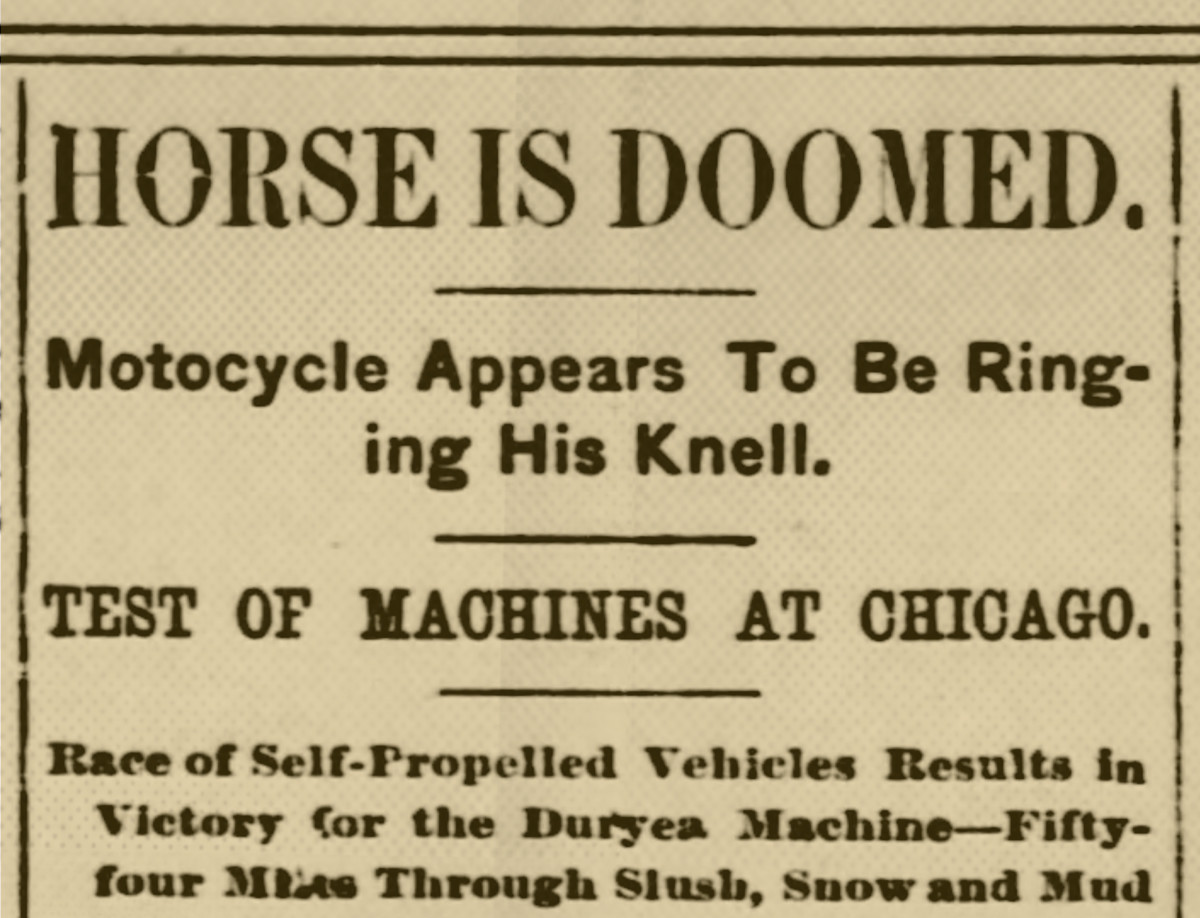Days of Blunder: The First U.S. Car Race Was Won 125 Years Ago ... at 7 mph
The front page of the Chicago Tribune on July 10, 1895, heralded the usual array of sensational stories, from political infighting to a diamond heist to a lethal factory fire. There was also some good news: WORLD TO BE SAVED proclaimed the headline above an article about the Christian Endeavor movement.
Nowhere, though, did the Tribune mention the announcement, made a day earlier, that in the fall the city would host something never before seen in the United States: a car race. The course would run between Chicago and Milwaukee, with $5,000 (nearly $155,000 in today’s money) in total prize money at stake.
That the Trib would overlook this news wasn’t a shock. For starters, another paper, the Chicago Times-Herald, was sponsoring the race. But more than professional rivalry, the fact remained that in 1895 cars were simply an anomaly. Most people hadn’t yet laid eyes on an engine-driven vehicle, let alone ridden in one. And those who had tended to react with horror and derision. Inventor Hiram Percy Maxim wrote in his 1935 memoir, Horseless Carriage Days, that the vehicle he was working on in 1895 “shook and trembled and rattled and clattered, spat oil, fire, smoke, and smell, and to a person who disliked machinery naturally, and who had been brought up to the shiny elegance and perfection of fine horse carriages, it was revolting.” It was common for a passerby to shout at a car’s operator, “Get a horse!”

This animosity was born not just of aesthetics; there was an economic element as well. At the time, there were 80,000 horses in Chicago, and in New York City the number was approaching 200,000. The animals were a substantial industry, and the people behind that industry—not just the people who bred and sold horses, but everyone involved in the carriage trade—weren’t about to see it go away without a fight. They pressured lawmakers to regulate their new competition, acting as sort of pony PACs.
In 1894, Vermont passed legislation similar to the Red Flag Act in England, which required that a vehicle have three operators—including one to walk ahead 60 yards with a red flag during the day, and a red lantern at night, to clear the way—and which limited a vehicle’s speed to 2 miles per hour. Pennsylvania’s legislature later passed an even more extreme law requiring the operator of any self-propelled vehicle that happened upon animals to immediately stop, disassemble the automobile and “conceal the various components out of sight behind nearby bushes until equestrian or livestock is sufficiently pacified.” (That proposal was vetoed by the governor.)
But there were enthusiasts, too, for the burgeoning mode of transportation, including the Times-Herald’s publisher. H.H. Kohlsaat’s newly merged paper was struggling, so more than a century before NASCAR gave us the Wawa 250 Powered By Coca-Cola—an actual event—he decided to sponsor a race as a means of drumming up business and readership. The publishing bigwig took credit for the idea, claiming to have been inspired by a race the previous summer in France, but it’s likely the competition was the brainchild of his science reporter. Either way, Kohlsaat was willing to open up his checkbook, and on July 9 his paper announced, “Five thousand dollars is hereby offered by the Times-Herald to successful competitors in a horseless carriage or vehicle motor race between Milwaukee and Chicago,” in the “belief that the invention and coming perfection of vehicle motor is destined to work a revolution in road transportation.”
Kohlsaat’s publication wasn’t the only one to embrace this new mode of transport. In 1895, three different journals sprung up, with strange names—The Autocar (based in England), The Horseless Age and The Motocycle—that underscored another issue: No one knew what to call these things. Everyone seemed to have their own idea (“horseless carriage” was popular; battery-operated vehicles were often called “electrobats;” and steam-powered vessels were “steamers”) so Kohlsaat offered a $500 prize for the best name. The winner, “motocycle,” would not remain in vogue for long.

Whatever the name, these journals were filled with propaganda in their favor. One early issue of The Motocycle opined, “Of all inventions, the alphabet and the printing press excepted, those inventions which abridge distance have done most for civilization.” Arguments were also made that motocycles would lead to better treatment of carriage-pulling horses—who would sometimes be left in the street if they died in the line of duty—and cleaner streets. By one estimate, New York City’s horses at the turn of the century produced 2.5 million pounds of manure a day. “A gusty wind will raise at any time in dry weather a cloud of dust, which is composed more than anything else of pulverized manure,” Scientific American wrote in December 1895. “The gravity of this nuisance, viewed from a sanitary standpoint, is not generally appreciated,” the journal added, somewhat superfluously.
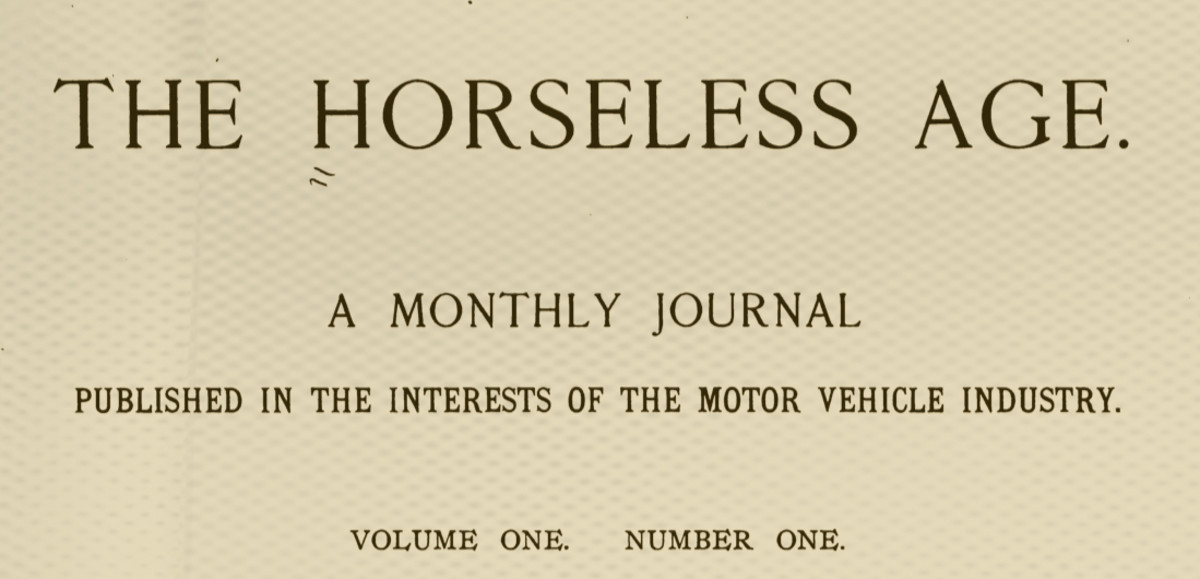
Perhaps the most interesting argument for the motocycle over the horse was put to paper a few years later by Rudyard Kipling. The future winner of the Nobel prize for literature, an early gearhead, wrote to a friend arguing that the motocycle was a “most efficient temperance advocate, and the only Education Act at present enforced, in Great Britain.” Unlike a carriage, he wrote, a motocycle required its operator to be both sober and learned. “When the man is more than usual drunk the beast will steer him home,” he wrote. “Not so the car. She demands of her driver a certain standard of education, the capacity of unflickering attention, and absolute sobriety.” Kipling continued: “It is the car ... that we have to thank for the quickened intellect, the alerter eye, the more agile limbs and the less unquenchable thirst of our fellow-citizens, as well as for the higher standard of decency now attained by our officially dumb companions.”
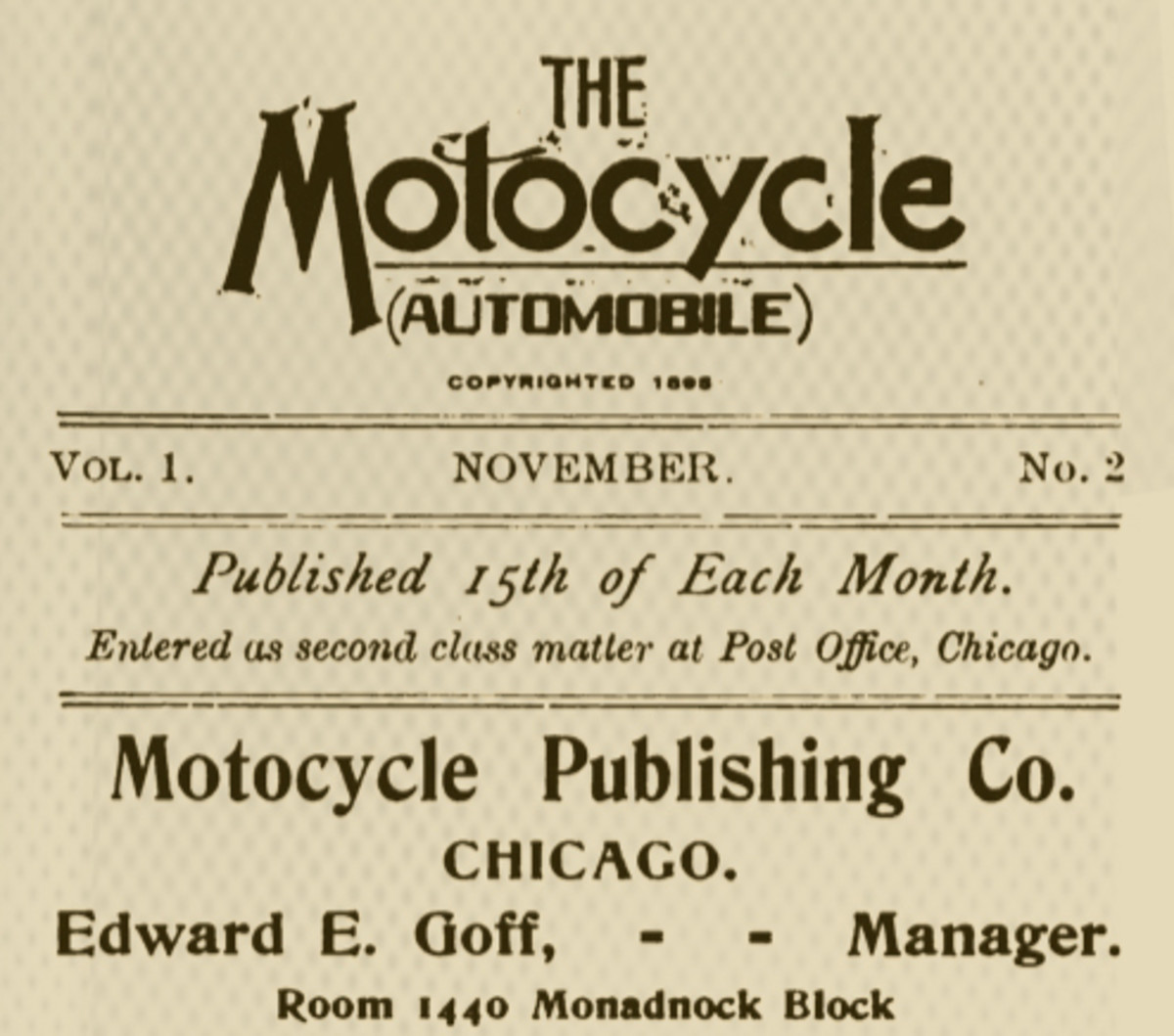
The journals of the day enumerated the various types of motocycles, and while they tended to be mind-numbing in their minutiae—imagine page after page of sentences like “The axletrees, which are fixed to the body of the wagon, divide at the end into vertical forks”—they did help inventors stay abreast of the latest developments. “As I look back,” the inventor Maxim wrote, “I am amazed that so many of us began work so nearly at the same time, and without the slightest notion that others were working on the problem.”
So the Times-Herald race of 1895 was less about competition than it was about proving that the motocycle was a reliable source of transportation. That and providing the far-flung hobbyists working on its development the chance to come together and lay eyes on one another’s machines.
***
Frank Duryea was the original automotive hot foot. Not because he could drive a motocycle fast—which he could, fast being a relative term—but because he had a habit of warming his feet in the stove as he sat up dreaming about ways to improve his contraption.
Duryea had grown up on a farm in Illinois, in the shadow of his brother Charles, who was six years older. When Charles graduated college in 1882 he delivered a speech on “rapid transit” that envisioned a time when “the humming of flying machines will be music over all lands.” Charles and Frank shared hobbies, including mechanical tinkering and reading scientific journals and patents. Around 1891, when they were living together near Springfield, Mass., they learned of the gas engine being developed in Germany by Nikolaus Otto.
Intrigued, they began work on their own version. In 1892, they somehow procured $1,000 in funding from Erwin F. Markham, a nurse with whom Charles had a passing acquaintance. Then Charles went back to Peoria to tend to business, leaving Frank to carry out and refine their work. He bounced ideas off of his friend David Nesbitt, who rented him a room. (Years later, Mrs. Nesbitt recalled: “Many a night, Mr. Duryea would work in the kitchen on his plans until quite late; sometimes he would fall asleep, with his feet in the oven.”) By the following fall, Frank had successfully taken a brief spin in what some today hold to be the first gas-powered automobile in the U.S.
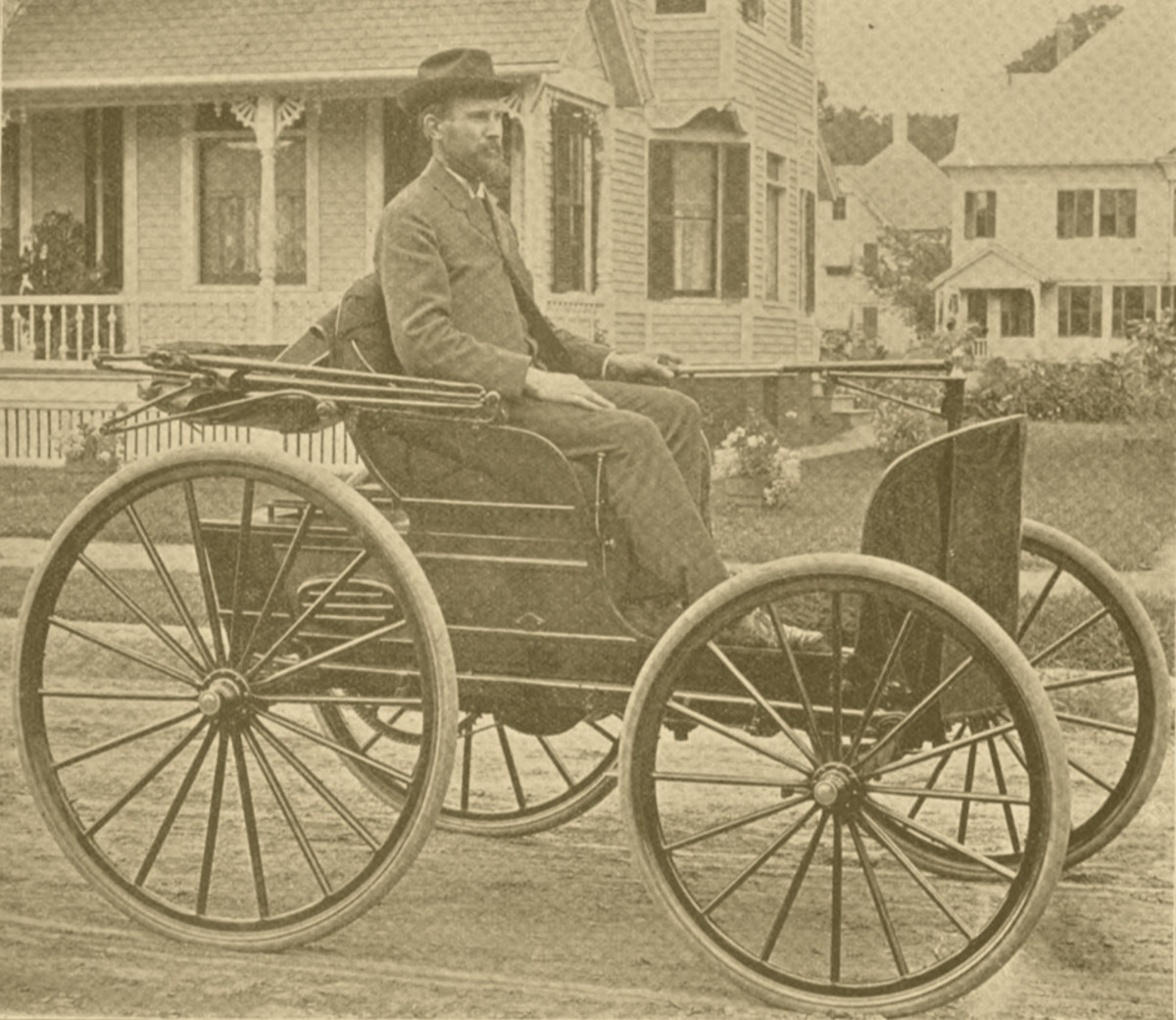
Come 1895, Frank Duryea was ready to race. Everyone else? Not so much. Kohlsaat had set a date of Nov. 2 and had received more than 80 entries, but by Halloween only one other machine was on-site and in racing shape: the gas vehicle of H.H. Mueller, of Decatur, Ind.
Another issue: Chicago itself wasn’t yet ready for a motocycle race. As Mueller drove his car into the city, he was stopped by police who told him he had no right to be on the street unless he was being pulled by a horse. Kohlsaat successfully scrambled to get the new vehicles road-approved, but he accepted that it was too soon for a race. Duryea’s arrival gave him just two cars, so he decided to push the actual contest back several weeks to Thanksgiving Day, Nov. 28, and in the meantime hold an exhibition, on Nov. 2. Duryea and Mueller’s Benz, piloted by his son Oscar, would drive to Waukegan, Ill., and back, with a purse of $500 to be split between whoever covered the 92 miles in under 13 hours. (A third vehicle, piloted by a notorious con artist named E.J. Pennington, showed up after the start and attempted to traverse the course.)
Kohlsaat’s competitors, throughout, delighted in seeing his dream event run into trouble, with one Tribune headline dubbing the exhibition a “scrub race.” When the day arrived, newspaper reports varied on the size of the crowd, with the Tribune asserting that “200 commuters ... and a crowd of interested spectators—only about 499,600 short of the advertised half a million”—were on hand. The Trib’s story recounted how Pennington’s vehicle “quit after interested citizens and small boys had pushed it up a hill which it could not climb otherwise” and even included a line drawing of the spectators shoving the motocycle.
Another paper reported that some 150,000 people peppered the route, suggesting that crowd estimates were just as sketchy 125 years ago as they are today. But there was definitely interest. When Mueller’s Benz hit the halfway point, Scientific American reported, “all Waukegan turned out to view the novel spectacle.” Duryea was cruising along at 15 miles per hour when he came upon a farmer’s wagon being pulled by a team of horses. He sounded his horn and went to pass on the left, but the farmer turned in the same direction, leaving Duryea with no choice but to drive into a ditch. Had the yellow flag been invented, it would have come out.
Mueller finished in 9 1/2 hours, driving at roughly 10 miles per hour. His car consumed just over five gallons of gas, at a total cost of less than $1.
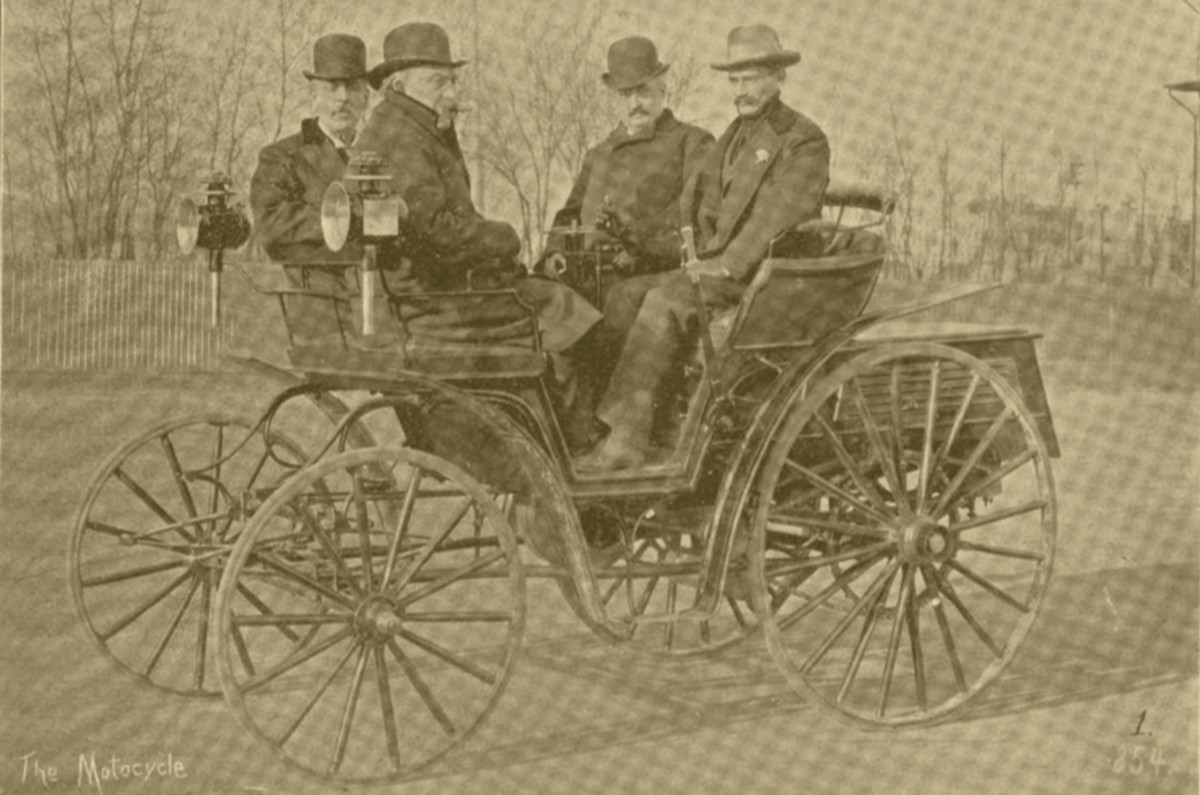
***
Four weeks later, Duryea’s motocycle was repaired, ready for action. And Kohlsaat’s race route was changed. Instead of Chicago to Milwaukee, the contestants would drive to Evanston and back, a 54-mile circuit.
The delay allowed for a bigger field, including one serious contender: Elwood Haynes. While the vehicle Duryea took out in 1893 is generally considered to be America’s first gas-powered automobile, Haynes long claimed that his first excursion, on Independence Day of 1894, should be considered the maiden drive. While the Duryeas had slapped a motor onto a horse carriage, Haynes reasoned, his vehicle, which he called the Pioneer, was built from scratch. (The Duryea brothers, ultimately, didn’t last long in the auto sales business, so there was no one to challenge Haynes when he used “America’s First Car” as the motto for his Haynes Automobile Company.)
Like the Duryeas, Haynes was a midwestern doodler who loved to read. Growing up in Portland, Ind., he devoured his sister’s chemistry book, leading to some strange hobbies for a 14-year-old. “The local legends of Portland,” wrote historian Ralph Gray, “include accounts of young ‘Wood’ Haynes scouring the neighborhood for broken pewter spoons and other metal objects so he might melt them in the small furnace he constructed.” While that sounds like the origin story of every serial killer in pop culture, in Haynes’s case it led to the Pioneer, which he confidently drove to the Midway Plaisance on that Thanksgiving Day in 1895.
Kohlsaat’s rescheduling, though, had not accounted for the weather of late-November Chicago. On the preceding Tuesday, a storm dumped 18 inches of snow, and while most of it had melted by Thursday morning, there was still a good five inches of slush on the streets. On the way to the starting line, at the corner of 38th and Indiana, Haynes swerved to avoid a streetcar and ran into the curb, breaking a wheel. His race was over before it began.
In the end, six cars made it to the morning start: Duryea’s, Mueller’s, two other gas-powered vehicles—one driven by Jerry O’Connor, one by Frederick C. Haas—and a pair that ran on electricity. (There was no way those cars’ batteries would provide enough juice to cover the course, even in the best of weather; and at 1,600-plus pounds, replacing them mid-race was not much of an option. So the two drivers resigned themselves to going as far as they could.)
The start was staggered, with one minute between departures, and it wouldn’t be a traditional sprint to the finish line. Competitors were individually timed, and an umpire riding shotgun in each car made subtractions for such impediments as railroad crossings. Even then, finishing the fastest didn’t guarantee winning. The top prize of $2,000 would be decided a week later by a panel of judges, using the results of the race as just one factor.

When the moment arrived, Duryea’s was the first motocycle off, at 8:55 a.m., with a reported crowd of several hundred watching. “Many cameras were leveled at the machines as they stood in the deep snow, and the Kodak fiend took snapshots of everything in sight,” the Times-Herald gleefully reported.
Duryea was followed by Haas, O’Connor and the electrics. Mueller, meanwhile, struggled to get his car started. By the time he joined the field, a little after 10, scarcely “a baker’s dozen” fans were there to see it. Along the route, though, there was interest, as families took time away from their Thanksgiving celebrations to see the novel machines. “Down Michigan Avenue, where the travel was better, the scene was more spirited,” wrote the Times-Herald. “At the windows of the wealthy and the notable there were clusters of faces—children, the matrons, the fathers and the babies. A moderate estimate would place the number of people on the walks ... at 10,000, and they were all discussing the motocycle—its merits and demerits.”
Alas, Haas’s vehicle never made it to Michigan Avenue; he dropped out less than two miles into the race and followed along in a sleigh, with a Times-Herald reporter. Haas’s bad day got worse when that sleigh overturned, sending him and the reporter into the snow.
Duryea, too, had mechanical problems, which allowed O’Conner to take a lead of more than half an hour—despite the fact that O’Conner had banged up his steering gear by rear-ending a horse-drawn street car. But by the time that pair reached Evanston, Duryea had closed the gap, and a little before 1 p.m. he made a less-than-daring pass for the lead. Under the rules of the race, O’Conner pulled to the side and let him by. Still, the Times-Herald reported, “the groups of spectators applauded the unusual sight of one horseless carriage forging ahead of its rivals.” (Some salt in the wound: Outside of Evanston, O’Conner came upon Haas’s crew and ran into their sleigh, doing further damage to his own steering gear.)
In so many ways the afternoon would resemble the fits and starts of what we’ve come to know as the auto race, albeit in slow motion. At 2:15, Duryea developed a problem with a “sparking plug” and embarked on a pit stop indicative of the time: He located a tinsmith and, finding the shop closed, went to the owner’s house, pulling him away from a Thanksgiving feast so Duryea could forge a new igniter. (Earlier, Duryea found a blacksmith who helped him forge a new steering arm.)
Strictly speaking, the race’s rule book forbid stopping for outside repairs (or, say, getting pushed through a snow drift, as Mueller’s Benz had been), but those rules went unenforced. In fact, in some cases the ride-along umpires openly cast their impartiality aside. It was a very cold day, and a very long one. Duryea was able to get his hands on a sandwich from his brother Charles at a relay station in Evanston, but Oscar Mueller wasn’t so lucky. He hadn’t eaten breakfast and, according to his umpire, Charles King, he’d eaten only a light snack for lunch. The competing cars didn’t have roofs, let alone heaters, so Mueller went to the next best thing to warm up on a frigid day: whiskey. The normally abstemious driver took several belts along the route, and by 7:50 p.m., with his motocycle three and a half miles from the finish, he passed out. King shuffled the unconscious man into the passenger seat and took the tiller, guiding the vehicle home an hour later. (Thankfully, the news never made it to Rudyard Kipling. Contemporary accounts attributed Mueller’s condition to exhaustion; 75 years later his grandson came clean.)
By the time King reached the finish line, Duryea had already come and gone, having been greeted by a sparse crowd at 7:18. “The congratulations were hearty,” reported the Times-Herald, though the Trib predictably presented a different view of the scene: “The judges had become disgusted and quit and no one witnessed the finish but two reporters.” O’Conner, meanwhile, was nowhere to be found. His steering had finally given out after he ran into a carriage at a railroad crossing, his third wreck of the day. After spending five hours trying to fix it, he gave up the ghost at 11:15 p.m.

In print, the Tribune’s seething recap, buried on page 8, jumped on that point, writing that the cars that didn’t finish were “wandering aimlessly about the streets of Chicago or lying wrecked in some gutter along the way.” Of Duryea’s finishing first, the paper opined: “No records, but various parts of the mechanism, were broken.”
But to the pro-motocycle crowd, the fact that the race had produced two finishers—Duryea was awarded first prize while Mueller took $1,500 for second—was significant, even if the winner’s average speed was 7 miles per hour. In its coverage, The Autocar quoted one judge, a Mr. F.U. Adams, who was as defiant in the face of criticism as his initials suggest, as saying: “The influence of the contest held yesterday upon American mechanics cannot be estimated by a glance at the superficial results. It is astounding that a self-propelled vehicle should be driven 54 miles through a sea of slush and mud at a speed which would kill any team of horses. It is remarkable that this vehicle should be guided over a course covered with pleasure carriages and crossed and cut up by railroad, cable and electric tracks without serious accident to the drivers, or the users of the highways.”
Or, as several newspapers put it more succinctly in a headline that appeared throughout the midwest the next day: HORSE IS DOOMED.
